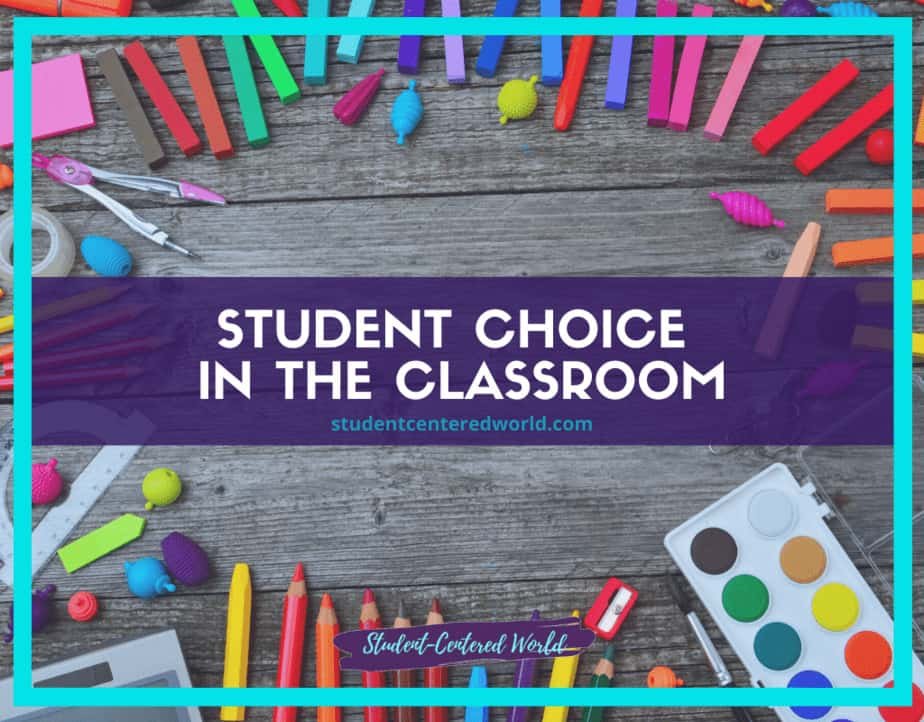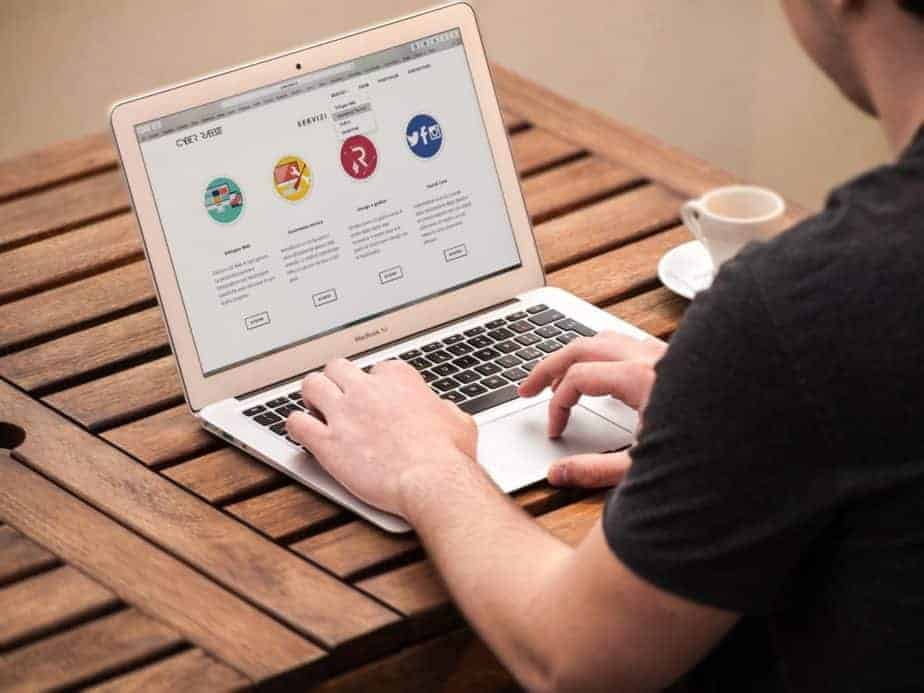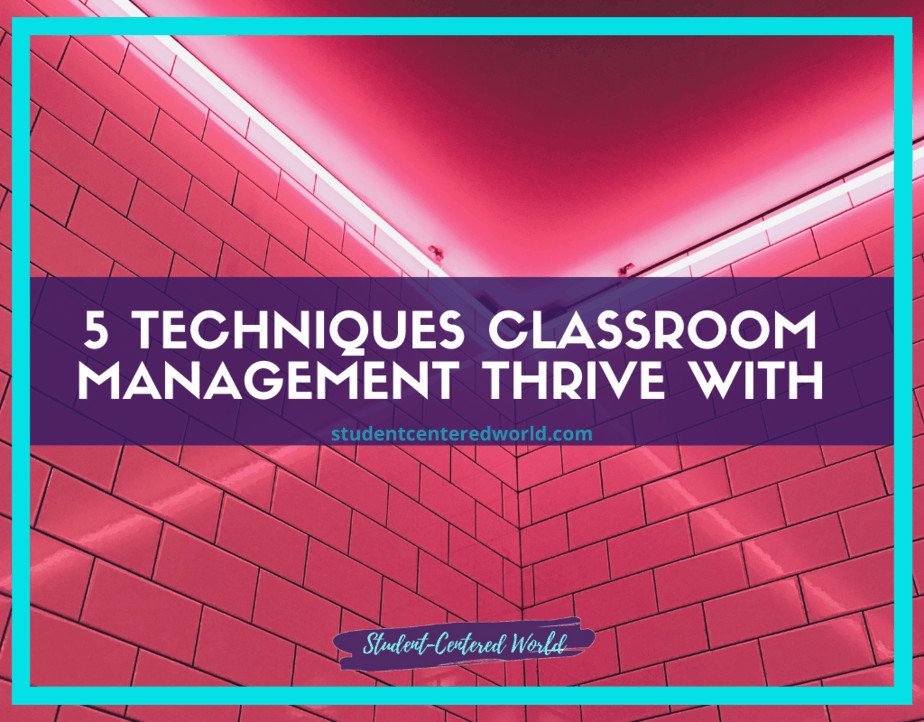5 Student-Centered Teaching Strategies You Can Easily Implement Tomorrow
Switching from a teacher-centered model in the classroom to a student-centered one can seem extremely overwhelming, but it doesn’t have to be. Often I have people come to me with one simple question, “What are some student-centered teaching strategies?”
In a way, it’s a loaded question. While student-centered learning has some very specific protocols to execute properly, it truly looks different for not only every teacher but for every collection of students in the classroom. What might work well for one group might not for another. So while there may be no “one-size-fits-all” answer for the question of what are some student-centered teaching strategies, there are some guidelines that any teacher can abide by.
The thing to realize is that this is okay and it just makes student-centered learning very fluid. It’s hard to wrap your mind around it, but this actually makes the process of teaching these students easier as the techniques ebb and flow with what works and what does not.
This in and of itself is a key element of student-centered teaching strategies. All student-led learning is created with the student in mind. This ranges anywhere from behavior and classroom management to content and standard mastery.
Easily answering the question, “What Are Some Student-Centered Teaching Strategies?”
It all comes down to a student’s understanding. We are trained as teachers that we need to make sure that we instill content knowledge into our students, but really learning is when a student understands a concept. Especially with our Generation Z students in the classroom today, it is imperative to make sure that we are teaching in a way that they understand as opposed to how previous generations learned.
Although this may look different anywhere from a classroom level to a course level to even a school year, it is not hard to determine the best methodology in implementing student-centered teaching strategies in trying to find the answer to the question, “what are some student-centered teaching strategies”. It just takes a little time for everyone to get on the same page, and then the magic begins.
Student Choice
Student choice is a huge piece of student-centered learning. We discuss this concept a lot here at Student-Centered World. To break it down, it is a lot like when you have a small child at home and you ask them if they want to wear their green coat or their blue coat that day. It really doesn’t matter what color coat they wear, just the fact that they’re wearing a coat. You’re happy because they are wearing a jacket and they are happy because they feel that they got to pick.
It’s the same concept in the classroom.

You are crafting activities and ways of distributing content that all have the same outcome, but the students feel that they can pick something that really appeals to them. If you are looking for student engagement, this is the route to go.
Flipping the Classroom
Flipping the classroom is also a huge component of student-centered teaching strategies. This is an option that often scares a lot of teachers. You can read about the flipped classroom here, but ultimately the initial learning of content information is done outside of the classroom and then it is utilized and reinforced within the classroom. This is probably one of the key ways, again, to answer that question, “what are some student-centered teaching strategies?”. This can be done in a number of ways, but most commonly with video on a platform like EdPuzzle.

Of course, the biggest concern is the question, “But what if the student doesn’t do the work” right? There is such a simple workaround for that and you can read about it in “The Flipped Classroom: A How-To Guide” here.
Utilizing Effective Brain Breaks
Brain breaks are also so important to make sure that your students are focused in the classroom. There are a million and one different brain breaks that you can try in the classroom, with some that energize and some that calm.
It is important to make sure, especially when you are looking at determining what are some student-centered teaching strategies, that your students are engaged on the same energy level, even if they are working on different activities or are at different points in a particular activity (refer back up to the student choice option above).

It is also so much easier to tell if your students do need a brain break with this model as you are interacting with each one on an individual level during every class period. You may notice that there needs to be a whole class activity or maybe something set up for just one student to be able to self-regulate and refresh themselves.
Regardless of the circumstance, the data says that everyone (adults and children alike) can focus more clearly and work better after the appropriate type of brain break. Also, this is another poignant answer when researching, “what are some student-centered teaching strategies”.
Here is also a great resource for a list of brain breaks in the classroom (ad)
Classroom Design
Honestly, how you design your classroom is also a huge element of the student-centered experience. If the design is factory-esque rows where the expectation is that students stay seated quietly the entire class period, this will not be conducive to a student-led learning environment that will be as successful as it could be.

Often when people start thinking about the options (ie. flexible seating), they start seeing dollar signs. This absolutely does not need to be the case. You can check out our article on the top 10 teacher tools for the student-centered classroom to get an idea of how to completely transform your classroom design on a dime. What are some student-centered teaching strategies? A few easy tweaks to your classroom!
Student Voice
How many of you were raised with the guidance that a child’s place is to sit down and shut up?
Isn’t it nice that all elements of life are finally breaking through that this is a terrible idea?

I’m not saying that kids should be disrespectful or flighty with their words or behavior, but listening to their needs is so imperative if we want to have the best outcomes in the classroom.
If we are meant to be ensuring that our students are mastering objectives (be them educational, social, emotional, etc.), shouldn’t we be heeding what is (or isn’t) actually working for them (and not just our perception of it)?
There are so many opportunities for this. We have a great podcast interview that chats all about tuning into your students’ needs and working with them in the classroom (and…spoiler alert…this particular classroom is virtual). Another option is by looking into student-led conferences, which are also a spot-on way for students to take ownership of their learning and voice, a great way to hone in on what are some student-centered teaching strategies.
Answering the call, “What are student-centered teaching strategies?”
Though each of the above options is crucial student-centered teaching strategies, so many people want more. They want to know specifically how to do all of this in their own classrooms…including curriculum. A logical question, right? The hardest part about having a definitive answer to the question “what are some student-centered teaching strategies” is that there isn’t much out there that explains the how. A LOT about the why, but not the how.
This is why I started Student-Centered World in 2018. I created a soup to nuts program guide that walks you through the entire process for K-12 teachers that includes all curriculum elements and all the pieces that I chatted about above.
If you are interested in joining the waitlist for the program, you can find information for “A Passion for Progress”, our signature 6-month program, here.
Student-Centered World Podcast Transcript
Below is the transcript from the Student-Centered World Podcast Episode 40: “Stressing Less in the Classroom”
Hey friends, and welcome to another week of the Student-Centered World podcast. I hope you had a good week this week. I hope you had some fun or at least relaxing things planned for this weekend. I want to take today to help you with a little bit of a mindset shift as I like to talk about what seems to be all of the time, but about student-centered learning in general and explain to you why in fact it does make your life less stressful.
Welcome to the Student-Centered World podcast where we talk about all things hands-on teaching and keeping your energy and sanity in the classroom. This teacher-turned consultant is making it her mission to help as many teachers as possible become the best version of themselves and keep their passion for teaching on fire. It’s her hope that we never forget why we desire to have a passion for educational progress. This is Student-Centered World, and this is Jenn Breisacher.
So, one of the biggest hang-ups I have, when I’m trying to talk to people about student-centered learning and making the shift, is, why bother? So, you have these teachers who have the mentality of if it isn’t broke, don’t fix it. Of course, the ones that will argue that we are dumbing down society, and we should have expectations of these kids like there always have been, and education is not supposed to be a fun song and dance and dog and pony show and all of this.
The people who make these arguments are thinking about things the wrong way. Number one, and you know that I’ve mentioned this so many times before, students and learning is in fact the way that our students that are in the classroom right now are learning the best period.
There’s data around it, I’ve explained it to you before. I’ve talked to you about why it worked in my classroom, why it’s worked in my Passion for Progress students classrooms, it’s because it’s how Generation Z learns. There is no other way around it. It doesn’t mean that we are making things easier. It doesn’t mean that we’re going and taking away the rigor. It doesn’t mean that we’re trying to gamify life for them.
If you want to think about it this way. It means we’re taking our curriculum; we’re meeting the students where they are which is what we are trained to do as teachers anyway and we’re making our own lives easier and less stressful in the process.
So, how is that even possible? Well, there are a number of different ways and a number of different angles that you can look at it. Number one, if you have less resistance in your classroom, you’re going to have more student engagement and there’s going to be more learning period. It doesn’t matter if you’re trying to get really tough with rigor, it doesn’t matter if you’re trying to get in-depth, it doesn’t matter if you have the lowest of the low students or the highest of the high students.
If they are more engaged in your classroom, there is going to be more learning. There’s no other way around that there’s no other way to look at it. And no matter what style, if you want to call it that way of teaching you’re looking at, that is the goal to have your students engaged and to have them learning. Student-centered learning puts it in their hands in a way where they are naturally being met where they are and helping them achieve more.
When doing this, you’re going to be able to find students who are struggling or who are not participating as readily as other students easier than if you’re trying to collectively teach all of them the same way. The nature of student-centered learning is that you have the ability to create relationships that are meaningful with every single student.
So, if you do have a student that is struggling or is not participating, or is bucking the system, you can have one on one time with that student to get to the root of the problem. As those numbers of students become less and less you either know exactly who you need to hone in on and call in reinforcements of you know, parents or guidance or whoever may be helpful in your particular situation but there are no great surprises.
There are no angry parent emails because you have the full ability to be on top of everything at all times. So, there isn’t finally you have the chance to sit down and get all caught up in grading and somebody’s grade suddenly drops and you have the parent emails or you’re trying to take the time to track the parents down to let them know that their student is not doing well in your class. Does that happen still? Yes. Does it happen as often? No.
That is the beauty of the main part of this. Think about how much of your life you would get back if you just didn’t have to deal with those aspects as often as you do now. Then you have the grading aspect in general, which is so much different because you’re not constantly giving assignments that you have to get back and then grade manually, and then keep that cycle going. You’re doing little check-ins, you’re doing little pieces of grading, every single day as your students are going through things. You’re able to help them on individual levels, which helps those grades improve.
Feeling Invigorated, not Deflated
If you use the techniques that I teach you, you’re using programs that are self-grading, giving you instant feedback so the time that we take and the turnaround that we normally have in a traditional teaching method of grading is eliminated. Are you still grading? Yes. Sometimes you might even, in theory, have more assignments graded in your grade book but it’s not graded and taking the time like traditionally it would, which is a huge, huge time saver. When it comes to planning you end up planning out lots of time in advance.
So, if you plan by unit, which is one of the ways that I teach you to do. You take the time upfront to get everything situated and then you’re working with the students and you’re interacting with the students and you’re not necessarily planning for the next day or planning for the next week. Obviously, it all breaks down to what you end up being comfortable with, but you end up getting all of this time back that you wouldn’t necessarily have had before.
You go home at night; you don’t feel like you have been put through the wringer. The classroom is already prepared for the next day and you’re ready to go. It isn’t normal to stay so late and goes home tired, do more work, go to sleep, wake up, and do it again. It just doesn’t exist with this method of teaching. As I’ve said a million times its not always rainbows and butterflies. Not every day is going to be perfect. There are going to be hiccups. Things are going to happen; the kids aren’t going to respond the way that you think that they will.
But the instances of that happening is so much less than in a traditional classroom. The whole key to this though is being able to take a step back and realize that everything that you’ve been taught about teaching needs to be reversed and amended and changed a little bit. But if you’re willing to make those concessions and those mindset shifts, and those little tweaks and changes, your life just becomes so much less stressful.
As a teacher you’re going in energized, you’re able to interact with every single student, all of your lessons naturally differentiate for every single student in there. You’re not grading like crazy; you do not lesson plan like crazy. You’re getting instant feedback. You’re being able to find the students that are falling through the cracks before they fall. You’re able to reach the highflyers that are able to get work done faster than everybody else that are normally the ones that get lost in the shuffle.
The kids that are going to struggle can identify faster and help them quicker. Literally all of the problems that we see day in and day out in the classroom. I’m not going to say they’re eliminated because always something can happen. But the instances of them happening are much, much less and you’re able to adapt and fix it so much faster. So, all the naysayers that are like, I don’t want to learn something new. I don’t want to change. What I’m doing is fine.
I asked this question. Is it really fine? Are your kids really doing the best they possibly can be? Do you go home not stressed out? Do you have time in your personal life for the things that you like to do? Or is your life consumed by your job during the school year and let’s be honest, during our breaks as well. Some of the best advice I ever got was in my first year of teaching, and that was that this is my job, it’s not my life. I always tried to live by that
Some days I lived by it better than others. I was a person that liked to take my Saturdays and use that to plan out the upcoming week or to make sure that whatever was ready was set to go or to grade long-term assignments or just take that time to do what I needed to do to prepare for the next week. But I know people that do this method that is able to do it during their prep periods that maybe stay just an hour after school each day and get the same amount of time done. It’s possible, it’s just finding what you are comfortable with.
I’m one of those people that I like to sit down and get done everything all at once, as opposed to doing things in little pieces. But plenty of people can do things in little pieces just as effectively. Again, it’s just finding what you’re comfortable with within all of this. But if you are not finding that you have this stress-less experience in the classroom then maybe this is something that you want to look into.
Maybe this is a change that you want to make. Again, I haven’t had one person that has fully gone through a Passion for Progress becoming a 100% student-centered educator and has implemented in their classroom and has not had the exact same effects that I am explaining to you right now that I had in my own classroom.
It took me five years to figure out this system but once I did, it worked over and over and over again. I’m hoping that in listening to this, you also realize that this could be something that might benefit you. That might save your mental health. That might help you not burn out, which might make you be reinvigorated to be a teacher again. I will be talking more about this next week in our next podcast episode that will be at 9 am Eastern Standard Time next Saturday.
I’m going to leave you with this. I’m going to hope that it marinates a little bit and then you digest it some. If you have any questions in the meantime, you can reach out. You can email me, admin@studentcenteredworld.com. Social media on Instagram and Facebook @studentcenteredworld and as always, I am happy to chat. Have a wonderful rest of your day.
Stop Driving the Teacher Struggle Bus
Are you struggling with student engagement, apathy, or keeping your class on track?
💫💫 There’s hope! 💫💫
Join my free teacher workshop “Choosing Choice” and in just 60 minutes, you’ll craft a practical plan to revitalize your teaching. Discover the magic of student choice in boosting engagement, gain quick implementation ideas, and explore strategies for year-long success.
Unlike overwhelming workshops, my approach guides you in real-time, providing more classroom options, reducing stress, and giving you more personal time.
Plus, you’ll earn a 1-hour professional development certificate and have 7 days of access.
Don’t miss this chance to transform your teaching; click below to secure your spot now!




